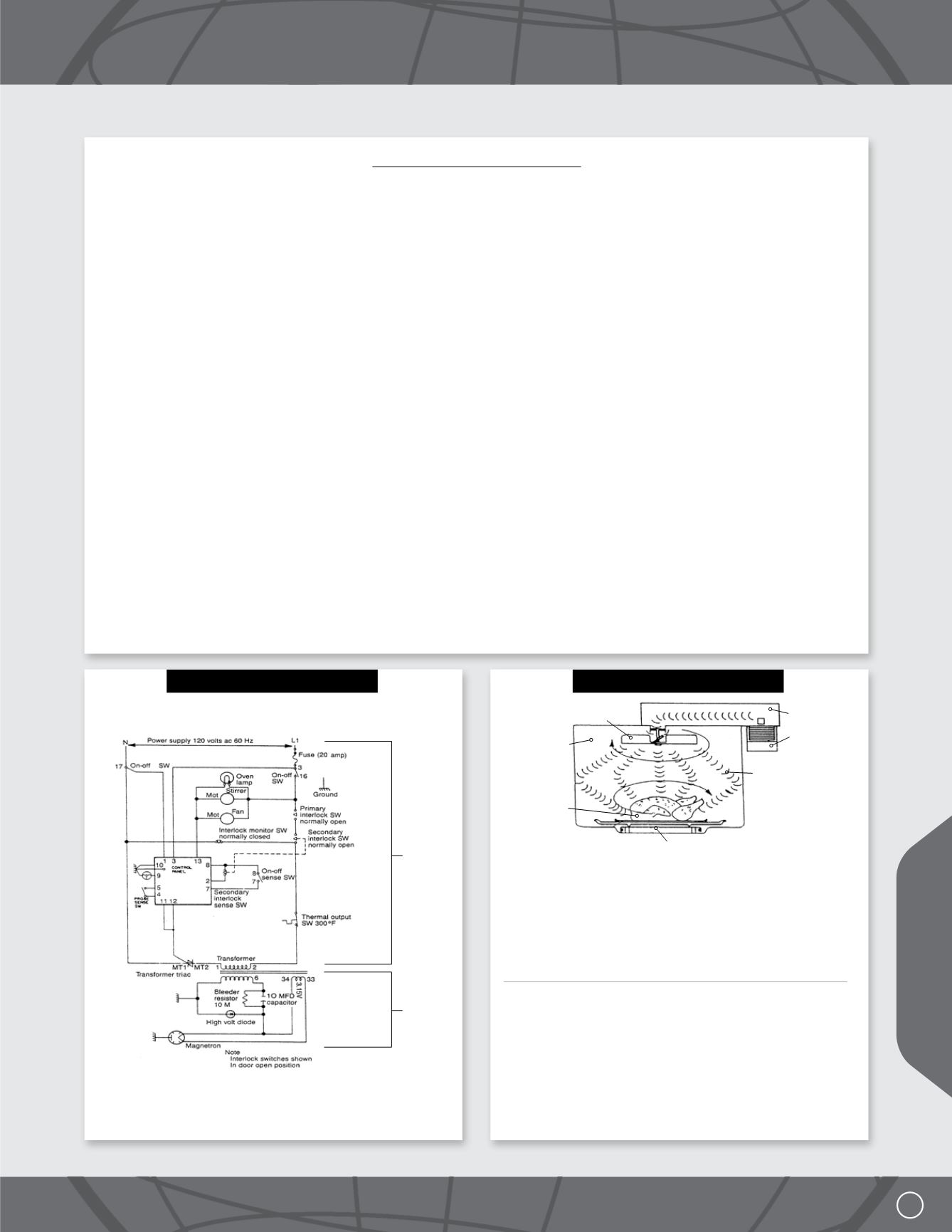

All logos, trademarks, part numbers, photos & illustrations are intended solely for identification.
Items offered for sale are not represented to be manufactured by the company that built the original equipment.
123
MICROWAVE OVEN OPERATION
MICROWAVE
How a Microwave Operates
The microwave oven produces RF energy in the form of Radio Waves that cycle 2450 million cycles per second. These
MICRO-WAVES have 3 main characteristics. They can penetrate certain materials as if it wasn’t even there, materials like
glass, mica, paper and some plastics. Secondly, there are materials like metal that the microwaves cannot penetrate and
basically just bounce off of. And thirdly, there are materials like FOOD that micro-waves do penetrate and basically are
absorbed in the material.
The food absorbs the microwaves and the microwaves cause the molecules in the food to move rapidly creating friction
between them which creates the heat that cooks the food. The microwaves only penetrate the outer portion of the food
but the heat is conducted inwards to cook the food completely.
It is the MAGNETRON in the microwave oven that produces the microwaves. The magnetron needs approx. 4000 Volts
to go into oscillation to generate the microwaves. The microwave oven has basically 2 sections, the low voltage section
which actually controls the unit and the high voltage section whose components include the magnetron and the com-
ponents that power up the magnetron. The high voltage transformer or the new style inverter is the component that
separates the 2 sides.
The low voltage (control section) takes the 120 volts, passes it through all the safety devices like the interlock switches,
thermal fuses and powers up the control device. On the older models the control device was the timer which told the
triac to close and send power to the high voltage transformer; on the new units it is the PCB control board that performs
that function. The fans, turntable motors and lights are also powered from the low voltage section.
The high voltage section consists of the high voltage transformer, the doubling circuit and the magnetron. The trans-
former takes the 120 volts from the low voltage section and increases it to approx. 2000 volts and feeds it to the dou-
bling circuit. The doubling circuit consists of the HV Capacitor and the HV diode. The HV diode converts the voltage to
DC and the capacitor discharges the 2000 volts and sends it to the magnetron. This adds to the 2000 volts that comes
direct from the HV transformer and gives the magnetron the 4000 Volts needed to go into oscillation. On some of the
new models this is all done by the inverter board.
The microwaves leave the magnetron through its antenna and goes into the waveguide where they bounce around
the metal waveguide and into the oven cavity until they are absorbed by the food. Some models have stirrer blades
to direct the microwaves randomly in the cavity to reduce uneven heating. Some models use a rotating tray to reduce
uneven heating. The glass tray is used so microwaves can enter the bottom of the food for complete penetration.
Typical Microwave Oven Schematic
Low
voltage
section
High
voltage
section
Microwave Cooking
1. Microwaves produced by magnetron enters the metal
waveguide.
2. Microwaves travel down the waveguide and are stirred up
by the stirrer blade as they enter the oven cavity.
3. As they enter the metal oven cavity they bounce around
until they are absorbed into food.
4. Microwaves absorbed in food set the molecules in such a
frenzied motion that they heat through friction.
Does the food in a microwave oven cook from the inside out?
Contrary to popular belief, microwaved food does not cook
from the inside out. Instead, the microwaves penetrate the
first 1" to 1-1/2" of the food, and heat is then drawn to the
center by conduction. The theory of food cooking from
the inside out comes from the fact that because the air in
the microwave is cool, heat dissipates off the surface of the
food quickly.
Waveguide
Magnetron
Microwaves
Turntable
Food
Oven Cavity
Stirrer Blade

















